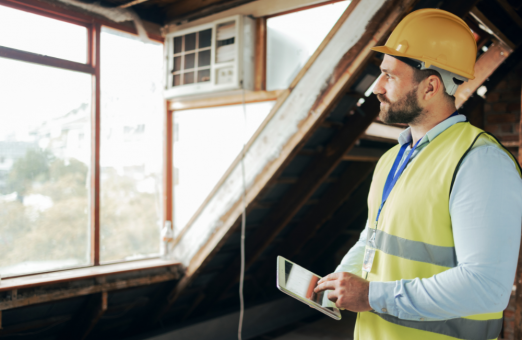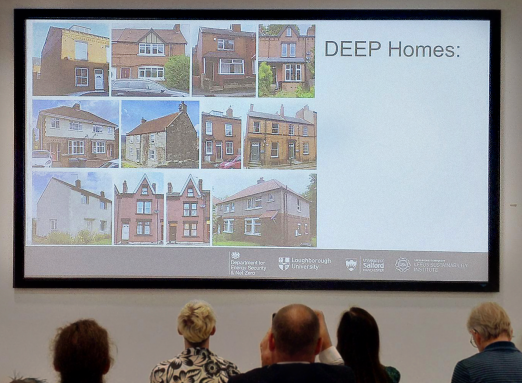“My method is to go back in history – it's a maverick approach",[1] so said one Professor of Architecture of “retrofitting”.
The concept of retrofitting became an urgent necessity during World War II, when weapons technology was advancing at an intense pace, and planes and ships were becoming outdated even before their construction was complete. The only solution was to retrofit the completed craft with brand-new technology.
But retrofit is more than just new technology. And it was probably the done thing well before WWII. In housing, it is the need to reframe how we think about our built assets, 80% of which will still be standing in 2050. It is the opportunity to embrace technological innovation, as well as to seize on inspiration from history, in fabric-first low-carbon building and more efficient energy use.
The UK Government’s mandated 2050 Net Zero target and directive to Build Back Greener[2] means the challenge to retrofit 1.5 homes per minute for the next 30 years is upon us. Housing accounts for around 26% of national carbon emissions,[3] a significant portion of that from operational space heating. By the time you’ve finished reading this article, that’s a further three.
For this, what may be termed a war effort is required, akin to the response to Covid-19. This may augur the provision of Nightingale Centres to assist construction site setup and mobility as well as vaccine levels of determination and collaboration to bring about a changed attitude to the importance of the built environment in its role in the preservation and restoration of our natural world. Lynne Sullivan OBE RIBA has recently argued for the creation of Retrofit Hub.[4] The scale is enormous and while we currently have numerous projects on site, tackling up to 100 properties at a time, much still remains to do.
Definitions of what Net Zero is with respect to retrofit abound. ‘The Government’s Retrofit for the Future Guide’[5], ‘LETI Climate Emergency Retrofit Guide’[6], ‘RICS Sustainability Report’[7], and now in the offing RICS residential retrofitting Professional Statement all offer valuable insight. PAS 2035 has led to increased rigour in the application of retrofit in terms of standards. Written off the back of the Each Home Counts[8] review, and supported by TrustMark, it is now generally mandated across public sector projects. PAS 2035 is an evolving beast and even if some of the challenges are still being ironed out, with other standards such as that on whole life carbon from the RICS not yet receiving its deserved uptake,[9] such initiatives are certainly taking the industry in a better direction, with increasing awareness and understanding among Clients.
There is increasingly a plethora of funding streams available, such as the Social Housing Decarbonisation Fund (SHDF)[10] and Local Authority Development (LAD)[11] funds for the public sector, which have helped stimulate commissions in this sector. This is now complemented by other low EPC, low-income support schemes including for those off the gas grid, as well as ECO+ for private householders, which is a welcome development.[12] The industry is moving more and more towards green EPCs and mortgages,[13] and the notion of stranded assets and those left behind looms large. However, despite calls from the Construction Leadership Council (CLC) for a National Retrofit Strategy (version 2 now launched), the message from the government continues to be mixed and inconsistent.
The retrofit agenda has certainly risen up in the news. This is not only because public activism has picked up, but also because consumers are increasingly feeling the effect on their wallets.[14] Numbers of live projects are gaining pace, with the retrofit package becoming steadily refined. Those practising retrofit are feeding back insight to industry professionals, sharing knowledge, partnerships and collaboration.[15] Monitoring data on retrofits completed over a year ago is showing good performance, better internal air quality and thermal comfort, and savings as high as 50% on fuel bills (relative to current energy unit cost trends), promising to close both the performance and health gaps.[16]
Though there are numerous challenges in delivery including lack of preparedness, the retrofit agenda is surely about more than just Net Zero.[17] Housing Providers and Asset Managers need to fine-tune their data and know the baseline they’re working from. Too many times with retrofit, projects are rushed into, data is incomplete, and existing defects are unaddressed, leaving time and cost overrun for remedial works that quite often relate to other budget streams. Strategic asset management, condition-led component replacement, valuing carbon (and embodied carbon), and resident disruption – these can all be drawn together – carefully, but not without challenge - in a successful retrofit. In embracing retrofit, there is the opportunity to enhance and widen the skills base, deepen our understanding of embodied and whole-life carbon, and explore biodiversity and ecology too, such as now reflected in the Planning mandate for Biodiversity Net Gain.[18]
There are the site challenges of retrofit. Every building is different, and “turning over” someone’s house is never easy with residents in situ. When things do go wrong, bad news can travel fast. Cost remains a significant stumbling block in the febrile construction market.[19] Whole house deep retrofit, once the watchword, is shifting. Slowly the perspective has moved to spread the jam a bit thinner, more bang for your pump.[20] Yet the pace still remains too slow with demand for more sustainable buildings sluggish (see graph).
So far this article has led from a technical, industry view on retrofit. But what does the word “retrofit” mean to those to whom it is being done? Some say the word sounds backward, regressive, and techy. Do we need a review of language - Sustainable Homes or similar? Because if residents or owners won't let us into their property, we are not going to get “retrofit” done.
Building surveyors are perfectly placed to bring together these various moving parts and the associated technical and project management skills to help run successful retrofit projects. Multi-disciplinary teams can help achieve efficiencies and meet demanding timescales, in a variety of capacities. A wide mix of building types will require retrofitting in the coming years. The challenges to each will vary and no matter how much “scaling up” is achieved, the need for attention to detail and a more particular approach to buildings in situ and people skills cannot be brushed over.
At Baily Garner, we have been working with the London Borough of Camden on a number of its demonstrator retrofit pilots, tackling hard-to-treat and designated property types under the SHDF Wave 1 funding stream. Brookes Court is situated in the Hatton Garden area of Central London and possesses significant space and technical constraints, including narrow access ways, adjacency to Locally Listed Buildings, narrow cavities and slate-hung mansard roofs. A package of fabric and ventilation upgrades is proposed to achieve EPC C and space heating of 90kWh/m2/yr. Belsize Grove is situated in Belsize Park Conservation Area, a mid-19th century property converted to bedsits in the middle of the last century, we are installing vapour-open solid wall insulation as well as high-performance windows, doors, single room heat recovery ventilators, PV panels, and high-performance electric heaters, owing to space challenges of installing new heat pump infrastructure. This project aims at the same energy performance outcomes. Effective engagement of Local Planners, stakeholders and residents on these projects has been key. Both projects are on display at the Building Centre this summer.
The construction sector has been often called a “conservative industry” showing little sign of a radically new responsive low-carbon architecture 23 years into the new century.[21] Issues over adversarial contracting and the race to the bottom have recently been in the spotlight, but these go back to Latham and Egan. False starts abound such as the failed Green Deal, Green Homes Grant, and most recently challenges faced by the Boiler Upgrade Scheme (BUS).[22] In fact, Britain has the lowest heat pump installation rate in Europe.[23] And PAS 2035 and other such developments have been a long time coming, with voices for better sustainability in the building going back decades.
Or might that be centuries? Perhaps in retrofitting, we have a brief window of opportunity - and it is brief because we are in a climate and ecological emergency, now - to re-embrace certain historical methods of building environmental performance - self-regulating houses, ventilation and heating around the built form, chocolate derived insulating panels![24] These are themes that may be picked up at the Building Centre’s exciting forthcoming Retrofit 23 exhibition and talk series[25]. Perhaps we need a new culture better attuned to the fluctuating, adaptive impetus of a changing climate. That alongside a more renewed focus on demand-side solutions as to how we use our buildings and energy,[26] facilitated through the use of smarter grid capacity planning and tariffs, may help us on that journey to a better place.
Notes
Matthew Allcock is a Chartered Building Surveyor at Baily Garner LLP, and a qualified Retrofit Coordinator. Matthew has been Project Manager on Energiesprong and SHDF Demonstrator and Wave 1/ 2 retrofit projects. He has undertaken PAS 2035 compliance assessment and has presented recently on retrofit for Social Housing Retrofit Accelerator and Unlock Net Zero. Matthew is part of the RICS Expert Working Group on a Retrofit Standard for the residential sector.
[1] A retrofitting revolution (cam.ac.uk)
[2] Net Zero Strategy: Build Back Greener - GOV.UK (www.gov.uk)
[3] Climate change insights, families and households, UK - Office for National Statistics (ons.gov.uk)
[4] A NATIONAL RETROFIT HUB - COLLABORATION + KNOWLEDGE FIT FOR THE CHALLENGE AHEAD (futurebuild.co.uk)
[5] Retrofit for the Future: a guide to making retrofit work - GOV.UK (www.gov.uk)
[6] Climate Emergency Retrofit Guide | LETI
[7] Green gauge: analysing the RICS Sustainability Report | Modus | RICS
[8] Each_Home_Counts__December_2016_.pdf (publishing.service.gov.uk)
[9] Whole Life Carbon Assessment for the Built Environment (rics.org)
[10] Apply for the Social Housing Decarbonisation Fund: Wave 2.1 (closed to applications) - GOV.UK (www.gov.uk)
[11] Green Homes Grant Local Authority Delivery scheme, Phase 2: funding allocated to Local Net Zero Hubs - GOV.UK (www.gov.uk)
[12] What is the UK Government’s ECO+ scheme? - Energy Saving Trust
[13] Green Mortgages (greenfinanceinstitute.co.uk)
[14] Electricity prices around the world | GlobalPetrolPrices.com
[15] Resources | Social Housing Retrofit Accelerator
[16] Retrofitting homes of non-traditional construction in Sutton (energiesprong.uk)
[17] Reducing embodied carbon in building materials | Journals | RICS
[18] Biodiversity Net Gain for local authorities | Local Government Association
[19] Inflation ‘adds £23bn to annual construction output costs’ | Construction News
[20] What does Whole House Retrofit mean to me? - Retrofit Academy
[21] Green gauge: analysing the RICS Sustainability Report | Modus | RICS
[22] £450m boiler upgrade scheme for England and Wales is failing to deliver | Renewable energy | The Guardian
[23] How to solve the UK’s heat pump problem - New Statesman
[24] Kajkao: a biodegradable material from cocoa - DesignWanted : DesignWanted
[25] RETROFIT 23: Towards Deep Retrofit | Exhibitions | What’s on | Building Centre
[26] https://www.creds.ac.uk/wp-content/uploads/CREDS-Role-of-energy-demand-report-2021.pdf







